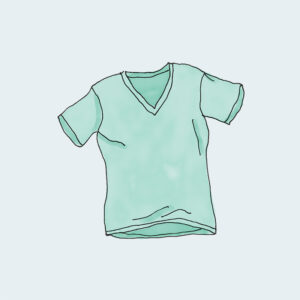Next Skin Type Quiz

What Is Mewing: How to Mew & Mewing Exercises For A Defined Jawline
- By Kaiwen Ying
- Last Updated October 1, 2023
Facebook
X
Pinterest
Are you looking for ways to get a chiseled and more defined jawline?
If so, you’ve come to the right place!
1-MINUTE SUMMARY...
Don’t have time to read through the whole thing? Here’s a quick 1-minute summary on how to mew and the mewing exercises.
- Correct Tongue Posture: Position the entire upper surface of your tongue against the roof of your mouth.
- Maintain The Posture: Retain this posture consistently, during rest, swallowing, or light speech.
- Check Lip and Jaw Position: Ensure lips are gently closed and teeth are lightly touching or slightly apart.
- Practice Correct Swallowing: Keep your tongue against the roof of your mouth when swallowing, without excessive muscle tension.
- Improved jawline and facial structure.
- Potential relief from sleep apnea, better oral health, enhanced posture, and improved breathing.
- May help in aligning the teeth and preventing oral issues.
- Could aid in better breathing by improving the position of the jaw and tongue.
- May improve head and neck posture, aiding in overall spinal alignment.
Anyone! Whether you are 10 years old or 30 years old, if you are looking to improve your facial structure, start mewing now! Mewing is a non-invasive, natural method for jawline enhancement (however, the earlier you start the bigger the difference you'll see).
Read the entire article to learn exactly how to mew and learn the common mistakes when mewing!
In this article, I’ll be talking about mewing and how it can improve your facial features, giving you that confident look you’ve always desired.
It’s a simple yet effective method that’s been gaining popularity recently.

Mewing. Maybe you’ve heard of it, maybe it’s a completely new concept to you.
Perhaps you’ve even spotted influencers and celebrities trying this technique on social media. The interest is spreading, and for good reason! Either way, let’s see how a simple technique can help you get the defined jawline that you’ve always wanted.
Before I get into the step-by-step guide, understanding what mewing is and who it is for is crucial.
Table of Contents
What Is Mewing?
Mewing is essentially a technique named after British orthodontist Dr. John Mew (side note: Dr. Mike Mew is his son), who proposed that the correct resting position of the tongue in the mouth influences the development of the facial structure.
It’s not just a beauty hack; it’s an orthodontic principle. Sounds simple, right? But the simplicity of the concept is precisely where the magic lies.
NOTE
Like learning to dance or play a musical instrument, mastering mewing comes with practice and understanding the little details about the technique.
Mewing engages the muscles of the face, neck, and jaw, working them to encourage natural growth and development in your facial features.
You might not even be aware of how your daily habits have shaped your appearance – mewing is a way to take control! It’s like physical exercise but for your face.
Who Mewing Is For
Mewing is for anyone and everyone who wants to improve their facial structure, particularly their jawline. It’s a non-invasive, no cosmetic surgery is needed, natural technique that can be practiced by people of all ages.
Whether you’re young and looking to enhance your looks or older and seeking a youthful touch, mewing is for you. It’s as versatile as it is beneficial.
NOTE: If you are looking for a defined jawline, read this and learn how to mew. Then learn how to lose fat to get a learner face, which will result in a sharper jawline. I will be writing a post on this soon.
Along with its health benefits, It’s great for people who want to get rid of their double chin and the saggy skin below their jaw. It’s not just about looking good; it’s about feeling good too.

How To Mew: A Step-by-Step Guide
Ready to try mewing? Let’s dive into the how-to of it all. But remember, just like any new skill, it is going to take a little time to get it right.
Here’s a step-by-step guide to getting your desired result:
1. The Correct Tongue Posture:
Start by finding the correct tongue posture. Press the entire upper surface of your tongue – the tip, the middle, and the back – against the roof of your mouth. Your tongue should be resting just above your upper front teeth, but not touching them.
2. Maintain The Posture:
Once your tongue is in the right place, the key is to maintain the facial posture as long as possible. This includes when you’re at rest, swallowing, or even lightly speaking.
I do this while I’m on the bus, going to the bathroom, watching “The Witcher”… basically everywhere I go!
3. Check Your Lip and Jaw Position:
To enhance the effectiveness of mewing, make sure your lips are gently closed and your teeth lightly touching or slightly apart. You should never be tensed up.
4. Practice Swallowing Correctly:
When swallowing, make sure your tongue remains against the roof of your mouth and the muscles of your face and neck don’t need to tense excessively. This felt very strange at first for me, but with time and practice, it becomes second nature.
If you are still unsure if you are mewing correctly, there are a ton of YouTube videos explaining how to do it!
The Importance of Proper Tongue Posture
Now, why is all this important? Proper tongue posture plays a pivotal role in mewing. It’s not just about aesthetics; it’s about functionality.
Consistently maintaining the correct posture strengthens your facial muscles and potentially influences your facial structure over time.
Think of it as fitness for your face. The more you do it, the faster you’ll see results.
In addition, proper tongue posture can contribute to better oral health, clearer speech, and even improved breathing.
To make things easier, I’m offering you a FREE routine/tracker calendar! No sign-ups needed. It’s a tool that can aid your journey and keep you motivated. Get the calendar here.
The Benefits of Mewing
Now, why should you care about mewing? That’s a great question! It might seem like a small thing, but it’s packed with potential.
Mewing has many potential benefits that extend beyond just aesthetic appeal. It has been suggested to improve:
- Your jawline, giving you a refined appearance
- Alleviate certain health problems such as sleep apnea, providing relief
- Improve posture, enhancing overall wellbeing
- Enhance breathing, for a better quality of life
Most of this is anecdotal evidence. Which means it isn’t scientifically proven – yet. However, it has shown to be effective across most people who mew on a daily basis.
If you are looking to improve your facial appearance and get a glow up, make sure to take a read on my comprehensive guide on how to glow up!
Controversies and Debates Surrounding Mewing
As with most things that seem too good to be true, mewing also comes with its share of controversies.
Some experts question the effectiveness of mewing, especially in adults, while others are concerned about the unrealistic expectations it may create.
Can you really get a better face shape just by repositioning your tongue and resting it at the “right position”.
No.
Mewing does not change your overall face shape (so if you have a round face, your face will still be round). However, it can bring you a more chiseled jawline.
If you are starting out at 25 years old compared to 20-year-olds and 12-year-olds, the results you’ll be getting won’t be as drastic as theirs.
Although the older you are, the less effective it is on your facial structure, you’ll still be seeing improvements in sleep and other benefits that come along with mewing.

Common Mistakes When Mewing
Mewing might sound simple, but I made a lot of mistakes when I first started. Even writing this, I’ve found that my tongue wasn’t fully stuck to the roof of my mouth. Listed are some bad habits and things to watch out for:
Incorrect Tongue Posture: Some people only place the front of the tongue on the roof of the mouth. Remember, the whole tongue, including the back, should be pressed up. There are several ways to check for this (read below)
Too Much Pressure: Overdoing the pressure can cause strain and discomfort in your jaw muscles. If mewing causes jaw pain, you are probably applying too much pressure. The key is consistent, gentle pressure.
Hard mewing is when someone applies a little bit more pressure on their tongue to the roof of their mouth. This can potentially speed up the process, but you need to be making sure it doesn’t cause any discomfort or pain.
Mouth Breathing: Even when you are not mewing, it’s imperative to breathe through your mouth. Studies have shown that not only it helps with breathing control, it also helps with:
- Dry mouth
- Snoring
- Bad breath
Forgetting to Mew: It’s easy to forget to keep up the tongue posture, especially when you’re just starting out. Setting regular reminders can be helpful.
Rushing the Process: Don’t expect instant results. Remember, mewing is a slow and gradual process. Patience is key. It probably took around 2-3 months of mewing and fat loss to get my jawline.
Mewing Exercises
Here are some exercises that you can do to help you mew. Although these exercises are optional, I would do these once or twice a week to get a slimmer and defined jawline.
Tongue Strengthening
Tongue strengthening is an essential aspect of mewing and facial development. It helps in achieving proper tongue posture, which is central to the effectiveness of the technique. Here’s how you can focus on strengthening your tongue:
- Chewing: Chewing isn’t just for breaking down food; it’s a way to work out your tongue and jaw muscles. Opting for foods that require more chewing (like raw vegetables or gum) can help you enhance tongue strength. Make sure to chew evenly on both sides and in a controlled manner. This exercise will not only work the tongue but also promote overall jawline definition.
- Push & Slide: This is a more targeted tongue exercise aimed at enhancing control and muscle tone. Begin by pressing the tip of your tongue against the roof of your mouth (as in proper mewing posture), then slide it back towards the soft palate as far as comfortable. Push and hold for a few seconds, then slide forward again. Repeat this action multiple times throughout the day. The “Push & Slide” method helps create awareness and control over the tongue muscles, making it easier to maintain the proper posture required for mewing.
Nasal Breathing Exercises
Nasal breathing exercises are vital for those practicing mewing, as they aid in improving overall breathing patterns, reducing stress, and enhancing facial development. I find myself doing these exercises when I’m stressed or feeling clouded. Here’s a closer look at two popular methods:
- Deep Breathing: This exercise is all about controlled inhalation and exhalation through the nose, emphasizing full lung expansion. To practice, sit or lie down comfortably, and take a slow, deep breath in through your nostrils, filling your lungs completely. Hold for a few seconds, then exhale slowly and entirely through your nose. Repeat several times, focusing on the sensation of the air flowing in and out of your nasal passages.
Deep breathing helps improve nasal airflow, strengthens respiratory muscles, and can even increase relaxation and mental clarity.
- Box Breathing: This exercise is about control and rhythm. Inhale through your nose for four counts, hold your breath for four counts, exhale through your nose for four counts, and then hold your breath again for four counts. Repeat the cycle. It’s known to help with relaxation and concentration.x
Facial Exercises
Facial exercises are designed to target and tone specific muscles in the face, leading to a more youthful appearance, improved facial structure, and even potential health benefits.
- Smiling & Swallowing: This unique exercise focuses on engaging the muscles around the mouth and throat. Begin by smiling broadly, then swallow while maintaining the smile. Repeat this process several times.
It’s a great way to tone the muscles, enhance your smile, and promote healthy swallowing patterns. It also supports proper tongue posture, aligning with mewing principles. Do this in front of a mirror! You can kill two birds with one stone by doing this exercise and improve your smile at the same time.
- Chin Tucks: Chin tucks are essential for defining the jawline and improving neck posture. To perform this exercise, stand or sit upright, then tuck your chin down towards your chest, creating a ‘double chin’ effect. Hold the position for a few seconds before returning to the starting position. Repeat several times. This exercise targets the muscles around the neck and jaw, and it can aid in reducing a double chin.
- Cheekbone Lift: Aimed at enhancing the prominence of the cheekbones and reducing sagging, the cheekbone lift is a targeted exercise. Place your fingers on your cheekbones, slightly press down, and then lift the skin upwards and outwards as you smile. Hold the position and repeat.
This is a fantastic way to lift sagging cheeks and emphasize the cheekbone structure, making it great to add into your mewing routine.
The Anatomy Behind Mewing
At the center of it all is your tongue, an incredibly versatile muscle responsible for various functions like speaking, swallowing, and tasting. When it comes to mewing, we’re particularly interested in where your tongue rests when it’s not actively performing any tasks.
This resting tongue posture, as per Dr. Mew, should ideally be against the roof of your mouth – from just right behind your front teeth to all the way to the back in your mouth.
The position of your tongue can influence the maxilla (your upper jaw) and the mandible (your lower jaw), which in turn affects the soft tissue, the structure, and the shape of your face. Again, to clarify, the your face shape won’t change from round to square. But having a more chiseled jawline can give off a “squarer” and a leaner face shape.
The Science of Mewing
At the heart of mewing lies the concept of bone remodeling.
Bone remodeling is a natural process where our bone tissue is continuously broken down and regenerated.
Dr. Mew’s theory suggests that applying constant pressure from the tongue on the roof of the mouth can guide the way your maxilla (upper jaw) develops and aligns with the mandible (lower jaw), influencing your facial structure over time.
This approach aligns with the principles of orthotropic, a field also pioneered by Dr. Mew, which emphasizes the importance of oral posture on facial growth, especially during early childhood. The earlier you do mewing, the more effective it is.
I’m 20 years old and I started mewing like a year ago. It has been working wonders!
Final Thoughts
As I wrap up, it’s crucial to remember that mewing requires consistency. Even though there is no scientific evidence yet, it doesn’t mean it won’t work. A lot of people are starting to do this, with social media being mainstream, and they are getting results.
It’s not a quick fix, but rather a long-term commitment. You probably won’t see a noticeable change within the next week or so. But just like any transformation, the journey of mewing involves patience, practice, and time. It’s about nurturing a new habit and integrating it into your daily life.
Frequently Asked Questions
How Do You Know If I Am Mewing Correctly?
To check if you are mewing correctly, ensure that your entire tongue is pressed against the roof of your mouth, with the tip just behind your upper front teeth. Your lips should be gently closed, and you should breathe through your nose without strain or discomfort. You can also perform a swallowing test by swallowing without moving. Mewing is a long consistent process, but the result is well worth it.
How Do You Do Mewing Properly?
Mewing properly involves placing the entire tongue against the roof of the mouth, with the tip just behind the upper front teeth. Lips should be gently closed, and breathing should be through the nose. To practice mewing, follow these steps: 1) Press the entire tongue against the roof of your mouth; 2) Keep lips gently closed; 3) Breathe through your nose; 4) Avoid strain or discomfort; 5) Perform a chin tuck for alignment if needed; 6) Test by swallowing without moving the tongue from its position.
How Long Does It Take To Get Results?
It depends! The better the technique and the more you mew, the faster you get your results. Aim for 6-8 weeks before seeing significant progress.
Do You Have A Mewing Tutorial?
Unfortunately, I do not have a video tutorial. There are plenty of great resources on YouTube that you can take a look at. However, stay tuned as I might start filming video examples and tutorials!





